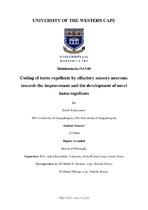| dc.contributor.advisor | Christoffels, Alan | |
| dc.contributor.author | Souleymane, Diallo | |
| dc.date.accessioned | 2021-03-25T09:06:59Z | |
| dc.date.available | 2021-03-25T09:06:59Z | |
| dc.date.issued | 2021 | |
| dc.identifier.uri | http://hdl.handle.net/11394/8039 | |
| dc.description | Philosophiae Doctor - PhD | en_US |
| dc.description.abstract | Tsetse flies are the biological vectors of human and animal trypanosomiasis and hence representant medical and veterinary importance. The sense of smell plays a significant role in tsetse and its ecological interaction, such as finding blood meal source, resting, and larvicidal sites and for mating. Tsetse olfactory behaviour can be exploited for their management; however, olfactory studies in tsetse flies are still fragmentary. Here in my PhD thesis, using scanning electron microscopy, electrophysiology, behaviour, bioinformatics and molecular biology techniques, I have investigated tsetse flies (Glossina fuscipes fuscipes) olfaction using behaviourally well studied odorants, tsetse repellent by comparing with attractant odour. Insect olfaction is mediated by olfactory sensory neurons (OSNs), located in olfactory sensilla, which are cuticular structures exposed to the environment through pore and create a platform for chemical communication. | en_US |
| dc.language.iso | en | en_US |
| dc.publisher | University of Western Cape | en_US |
| dc.subject | Glossina fuscipes fuscipes | en_US |
| dc.subject | Feeding deterrence | en_US |
| dc.subject | Olfactory sensory neurons | en_US |
| dc.subject | Chemosensory proteins | en_US |
| dc.subject | Odorant receptors deorphanization | en_US |
| dc.title | Coding of tsetse repellents by olfactory sensory neurons: towards the improvement and the development of novel tsetse repellents | en_US |
| dc.rights.holder | University of Western Cape | en_US |

